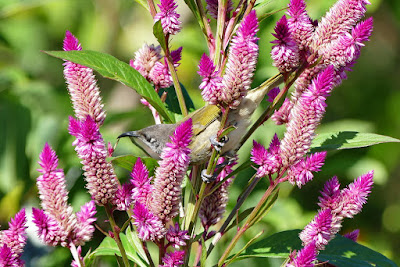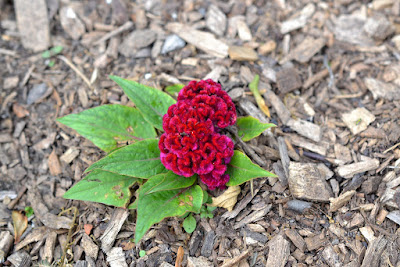Celosia plant also called as Woolflowers, is a genus in the Amaranthaceae family. They are versatile plants that have been used as herbal remedies, as ornamental annuals in the garden and as cut and dry flowers with eye-catching flowers that come in many different colors and forms. The generic name is derived from the Greek word kelos, meaning "burned," and refers to the flame-like flower heads.
Celosia plant also called as Woolflowers, is a genus in the Amaranthaceae family. They are versatile plants that have been used as herbal remedies, as ornamental annuals in the garden and as cut and dry flowers with eye-catching flowers that come in many different colors and forms. The generic name is derived from the Greek word kelos, meaning "burned," and refers to the flame-like flower heads.
IDENTIFY CELOSIA PLANT - WOOLFLOWERS
Celosia plant is native to subtropical and temperate regions of Africa, North and South America, and Asia. A dark red crested version of the plant was introduced into Europe in 1570. During the 18th century, the plants were considered a potted plant by the British while with the American colonists, they were a popular garden flower.
Woolflowers are shrubs, subshrubs, or annual herbs are characterized by alternate simple or lobed leaves and small showy flowers in dense spikes. The brightly colored and showy-red, purple, pink, orange and yellow inflorescences of cultivated forms are often flattened or undulating and form compact or feathery clusters.
Celosia plants are classified into three groups: a crested type, a plume type and a spiked or wheat type:
- Crested Celosia - belong to the Celosia cristata variety. They have flowers that resemble a rooster’s comb, hence the common name of ‘cockscomb flower.’ These flowers are also said to resemble to look of a brain or are often compared to coral. These flowers are typically available in vibrant and striking colors, such as dark red, and gold; however, it’s common for the plant to only produce one flower at a time. This variety is the largest of all the celosia plants.
- Plumed Celosia - belong to the Celosia plumosa variety. They feature feathery soft flowers that have a velvety texture. The foliage of this variety is quite broad, forming a dense base from which the flowers stand high above.
- Spiked Celosia - belong to the Celosia spicata variety. The flowers resemble wheatgrass, and therefore, this type of celosia is also sometimes referred to as wheat celosia. The flowers of these varieties stand upright like tall candles and appear in more subtle colors compared to other celosia flowers. The plant produces such an abundance of flower stems that it can actually become so dense that it takes on the appearance of a shrub.
The plant is mostly uses as an ornamental indoors plant. Their leaves and flowers also uses as food in South America, India and Western Africa. It has also medicinal value. It uses as treatment for blood clotting, intestinal worm (Tape worm), mouth sores, and eyes problems. The seed are used for chest problem and the flower are used for treating diarrhea. The leaves are used as external dressing, as treatment for burn and sores, and its boiled vegetative parts are said to be slightly diuretic.
CELOSIA PLANT - WOOLFLOWERS CARE AND CULTURE
Cultural information should only be used as a guide, and should be to be adapted to suit you. Your physical location; where you grow your plants, how much time you have to devote to their care, and many other factors, will need to be taken into account. Only then can you decide on the cultural methods that best suit you and your plants.
Light:
Celosia plant thrives when planted in full sun. Known as a short-day plant, flower initiation begins when the day length is short, preferably between 12–13 hours. However, longer days allow for longer stem development. If growing under short days provide additional lighting to prevent plants from flowering on short plants and stem. Time your plantings to allow for the required amount of daylight. Inadequate day length can cause deformation of flowers, comb shattering, or flat stems. If growing when natural day length is longer than 12–13 hours, provide a dark period to limit day length for 5–6 weeks.
One or two layers of horizontal netting as support are recommended to ensure straight stems. Shade is only necessary if light intensity is very high.
Temperature:
Woolflowers need warm temperatures upwards of 80 °F to germinate, and they also need continued warm weather to thrive once mature. They are commonly grown as annuals in zones 2 to 9, but they can survive as perennials in USDA plant hardiness zones 10 and 11, where winter temperatures do not drop lower than 30 °F.
They cannot tolerate any frost or freezing temperatures. In the event of a late spring frost, protect young plants by covering them overnight with a sheet, frost blanket or an inverted bucket or box. Remove any material used to cover the plants the following morning. Potted plants should be moved into a protected area on exceptionally cold nights.
Substrate and growing media:
In USDA Hardiness Zones 2-10, the plants can be grown outdoors in full sun to partial shade. It is a perennial in zones 9 and 10, and can also be grown indoors as a houseplant. They performs well in containers, and can easily be grown indoors, resulting in a more compact plant than when planted directly in the soil.
Any well drained soil is good, but the plants will perform the best when grown in fertile soil with plenty of organic matter - prepare the soil ahead of planting by adding leaf mold, peat, aged manure, or compost, if needed - and a pH of 6.0-7.0. Poorly drained soils can cause the plants to develop root rot.
Watering:
Provide consistent adequate irrigation until flowers begin to develop, especially during germination. You should not allow the soil or the original root ball to completely dry out. During periods of drought or extreme summer heat, you may need to water as often as every few days. To determine if your plant needs water, dig a few inches into the soil next to the plant. If the soil is dry 2-3 inches below the surface, it is time to water.
Overwatering can be as damaging as under watering. Be sure that the area surrounding your plant has adequate drainage to move water away from the plant. If you choose to plant in a container, always select one with drainage holes to prevent your plant's roots from sitting in water. Significant amounts of water stress can cause the flowers to bloom prematurely on short stems. Stopping irrigation after flowers have started to form can help prevent the incidence of disease.
Fertilizer:
Celosia plant requires a large amount of nutrients, especially nitrogen, fertilizers with a nitrogen-phosphorus-potassium ratio of 3:1:2, 20:10:20, or 15:5:15 serve the cockscomb best. Regular fertilization is needed for celosia to reach its full vigor of 10-30 inches depending on the cultivar. The liquid or granular fertilizer can be used for this plant. Keeping the soil mostly moist but not drenched and also applies dry granular fertilizer with a spreader or by sprinkling around the plant of cockscomb by hand. Repeat the fertilization process once twice per month.
Apply a 2-4 inch layer of shredded bark, compost, leaves, straw or other organic matter around your plants to promote moisture retention, maintain even soil temperatures and discourage weed growth. Replenish the mulch as needed.
Pruning:
Pinching is recommended to increase branching (the number of stems and flowers produced) and uniform flower size. When the plants are 8-12 inches tall, pinch the stem with your thumb and index finger or use sterilized scissors to remove the growing point.
Clip off dead, damaged or unsightly growth as needed to maintain an attractive appearance. The flowers are long-lasting and remain on the plants for weeks, so deadheading is rarely needed.
Hearvests:
Typically, the flowers bloom until the first frost, which will kill them off, though it’s a good idea to cut the flowers just before the first expected frost, as they make excellent bouquets. You can expect cut the flowers to last up to 10 days in a vase of water.
They are exceptional as a cut flower either when harvested fresh or as a dried flower. For fresh use, harvest when the flowers are fully developed. As a dried flower, harvest at the same stage of growth as you would for fresh flowers. Remove all foliage and hang in a dark, well-ventilated location to dry.
Pests and diseases:
Celosia plant suffers from a few diseases, including powdery mildew, oedema and fungal leaf spot. These problems can usually be avoided through good cultural practices. Space celosia at least 6 to 12 inches apart so air circulates freely. Use soaker hoses instead of overhead sprinklers, which encourage the spread of disease, and avoid working in the garden when it’s wet. Fungicides are helpful, but rarely necessary for this annual plant. In severe cases, remove and discard diseased plants.
Nematodes or mites can occasionally infest the plants, but in most cases, the damage isn’t severe. Move the plants in a new location if you experience these pest problems.
Propagation:
Woolflowers grow well from seed, germinating easily in the right conditions. The plant blooms approximately three months after germination, so it’s a good idea to get a head start on the growing season and sow the seeds indoors around six weeks before the last frost is expected, as this will produce earlier flowers.
Seeds will germinate in 8-14 days when started at temperatures of 70-80°F/21-27°C. Cover lightly with vermiculate, still allowing some light to reach the seeds as light aids germination. Bottom water or mist lightly to avoid covering seeds. Do not let the soil dry out during germination.
Sow 2-3 seeds per cell in 28 to 50 cell plug trays 6-8 weeks before last frost date. Celosia dislikes root disturbance, and so sowing in open flats is not recommended. Seedlings should not be allowed to become root bound at risk of transplant shock, or other damage to the root system.
Once seedlings have emerged or any time before the plants have 2 sets of true leaves, thin to one plant per cell. If seeds were sown into small-cell plug trays, transplant the seedlings into larger containers or cells. Grow seedlings at 63-68°F/17-20°C night temperatures and long days.
To acclimate the plants to outdoor conditions, reduce water for a few days prior to transplanting. Place the trays outdoors in a protected area in partial shade during the day, bringing them indoors each night. Gradually increase the plants’ exposure to full sun. After approximately 1 week, transplant outside after the last frost-free date, spacing 9-12 inches on center. A wider spacing can increase airflow and reduce the incidence of disease.
















COMMENTS